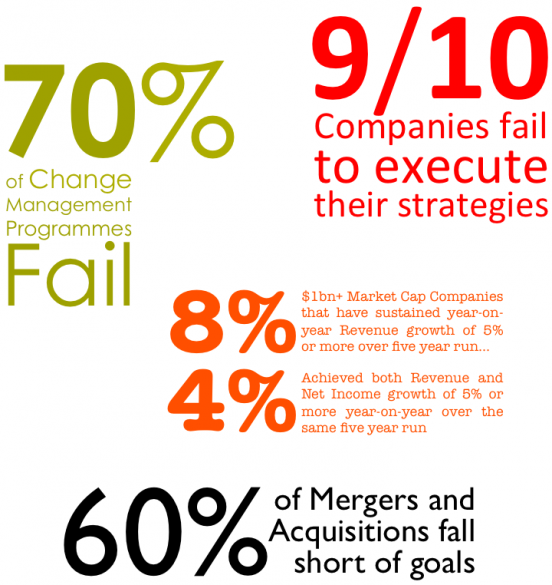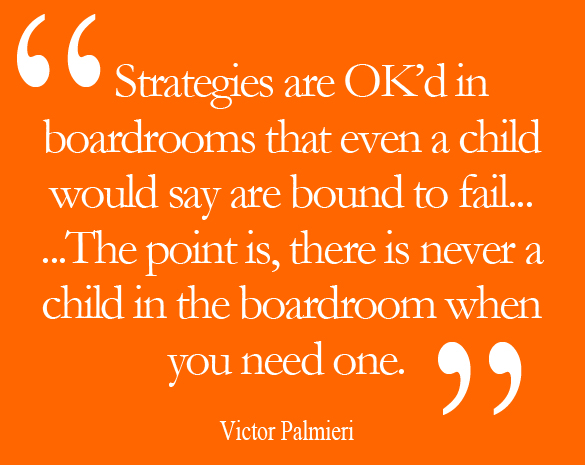 Failed strategies, like nuclear incidents and plane crashes, only rarely occur due to one catastrophic exogenous shock. These disasters, along with industrial accidents, oil spills, sinking ships and other man-made calamities, usually being the result of the cumulative effect of many smaller – individually insignificant – errors or mishaps.
Failed strategies, like nuclear incidents and plane crashes, only rarely occur due to one catastrophic exogenous shock. These disasters, along with industrial accidents, oil spills, sinking ships and other man-made calamities, usually being the result of the cumulative effect of many smaller – individually insignificant – errors or mishaps.
What Goes Wrong…
The typical plane crash involves seven consecutive errors, mainly human. Each one by itself may not present a problem, if acted on or contained in isolation – a malfunctioning or obscured warning light, a misinterpretation or miscommunication between the pilot and air traffic control, unfamiliarity with a particular situation or context, a brief distraction during a critical task, for example. But when compounded these have a cumulative effect that leads to disaster. No single big thing goes wrong, rather, unrelated events occurring in sequence spiral out of control and are usually worsened by human factors that have an escalating effect.
Similarly, the history of nuclear incidents and accidents is littered with the amplifying effect of many seemingly small malfunctions and mistakes. The partial meltdown at Pennsylvania’s Three Mile Island Unit 2 in 1979 was the result of such a chain of events. Firstly the failure of one of the valves that controlled coolant flow into the reactor, followed by a stuck open relief valve which allowed large amounts of coolant to escape. The mechanical breakdowns were compounded by the initial failure of the plant operators to spot the loss of coolant, through a combination of inadequate training, ambiguous control room indicators, and an indicator light being covered by a maintenance tag attached to a nearby switch. This dangerous cocktail of individually innocuous ingredients resulted in the operator overriding the automatic emergency cooling system mistakenly believing that there was too much coolant water in the reactor, when in fact it was depleting allowing the fuel rods to overheat and collapse.
Even the recent Fukushima nuclear disaster in Japan was not caused directly or solely by the original earthquake – which was within design limits of 3 of the 6 reactors – but the subsequent 13-15m high tsunami, which was well above the 5.7m the plant was designed to withstand, and the chain of events that followed. Later investigations found that the disaster was compounded and prolonged by human error.
The thankful infrequency of such disasters demonstrates the degree of rigour we have come to expect in the design of such complex systems and these exceptions prove the rule of just how well honed and invisible we have made the complexity of such systems and the intensely deep design that makes them work. As we settle into our seat before take-off, sip our champagne or are offered the obligatory ‘hot towel’, we choose not to consciously acknowledge the thrust, the acceleration, the speed, the altitude, the temperature, the tons of explosive jet fuel packed beneath us, the infinite complexity of the on-board systems, the hazards around us in three dimensions, and the very real risks of take-off and landing (I once heard a pilot define transatlantic flights as “6 hours or boredom sandwiched between 20 minutes of sheer panic at each end”!). While I don’t think every passenger should obsess about these things whenever we board a plane, I would not want to fly on an aircraft where the designers hadn’t; or where they had chosen not to explore the many possible modes of failure.
When disasters do happen, they demonstrate that despite rigorous testing and well developed ‘failure modes and effects analysis’ (FMEA) techniques, it is practically impossible to develop failure scenarios for all eventualities and commercially unviable to design against them all. They also exhibit a phenomenon of complex systems and the increasingly volatile, uncertain, complex and ambiguous world we live in: while it may be possible to piece together an explanation and believe we ‘understand’ a situation in hindsight, it is becoming increasingly perplexing to understand all possible outcomes ahead of time and near impossible to forecast what specifically will transpire.
The Poor Safety Record of Strategies and Organisational Change…
So, what does all this have to do with strategy?
Thankfully, nuclear power plants, airplanes, oil rigs and the like don’t have the same ‘safety record’ as corporate strategies. Whatever statistics you look at, strategies, breakthroughs, system-wide innovations, company-wide transformations and even sustainable year-on-year profitable growth are elusive.
Some of these statistics have become clichéd and hackneyed, but that doesn’t make them any less shocking.
Many strategies are doomed at their inception. A lack of identifying or grappling with a critical challenge or opportunity, the confusion between goal-setting and strategy, and the propensity for fluff, jargon and outright BS all contributing to too many stillborn strategies.
Many such strategies will never be capable of getting off the ground. Yet others will fall apart mid-flight because even the most obvious failure modes have not been understood.
And if these internal hurdles aren’t enough, the external environment is becoming increasingly turbulent, delivering greater shocks more frequently.
The Upside…
In a strategic context, there is an upside in all this negative data and risk of failure. The very fact that delivering strategy and making change happen is so difficult creates a disproportionate advantage when we do it well – there are huge benefits of being the 1 out of 10! Learning from failures in complex systems, we can develop some key principles that apply to the many moving parts necessary to develop, deploy and deliver a winning strategy in an increasingly volatile, uncertain, complex and ambiguous world. A few key themes to keep in mind include:
- Human Factors – When looking at the cause of failure of complex systems the biggest contributor is typically ‘Human Error’. Given that organisations – and any attempt to change them or get them to act differently – are human-centred ventures, it’s surprising that we still often underestimate the ‘human dimension’ of making strategy happen. Too many ‘strategic plans’ are merely mechanical; analytical exercises that, although logically well thought-through, miss the human dimension and fail to engage people in bringing it to life. While businesses have physical assets, structures and processes, we need to approach them as more that just ‘mechanical systems’ – without people, they are just decaying assets. Healthy organisations are human-centred endeavours and as such, we need to approach them as living ‘eco-systems’.
- Freedom within a Framework – When it comes to developing, deploying and delivering strategy too much structure is constraining, while some structure is liberating. For organisations to respond and adapt in the face of volatile and unpredictable circumstances we need to learn what makes some systems resilient, agile and adaptable. An organisation of any size needs to align and coordinate actions across boundaries – functional, geographic, category, divisional, etc. – which calls for an organising framework to convert strategic choices into coherent action. However, trying to predict every possible outcome and design the response ahead of time is becoming increasingly elusive and, against a backdrop of increasing external change results in a very rigid structure which will be more susceptible to the compounding effect of minor deviations and more fragile in the face of large shocks. An organising framework needs to be coupled with the ‘space’, and ‘capability’ for different parts of the organisation to respond and adapt to change when confronted with it while feeding the learning from this back into the overall system.
- A Range of Critical Balances – The many moving parts of a complex system, like the coordinated moves necessary to execute a winning strategy, require the continuous striking of a range of critical balances. Unlike mechanical systems, healthy living organisations have the ability for self-organisation – in biology this is called evolution, or in human economies called market forces. The ability to contend with change, overcome entropy and continually reconcile and create value from the many different perspectives at work in an organisation requires us to walk the tightrope between order and chaos. While a tricky balance, the prize is continual adaptability against a backdrop of change, as Christopher Langton observed, innovative systems constantly veer toward the ‘edge of chaos’, a state that is neither fully predictable nor fully anarchic. These balancing acts take many forms; people–process, simplicity–complexity, focus–peripheral vision, control–growth, direction–discovery, to name a few. Your unique circumstances, organisational values, and the consequences and choices that flow from developing your unique proposition and strategy, will create your own distinctive set of balances. Identifying, understanding and continually striking these balances is a key part of distinguishing your organisation from the crowd and keeping it adaptable in the face of change.
- Connections and Connectors – Often the major components of a system – or a strategy – may appear individually sound, but it’s the lack of alignment and integration between them that amplifies weaknesses. Overcoming this In an organisational setting, making sure the strength and integrity of the parts strengthens the whole, relies on the connections and connectors – the combination of ‘hard’ and ‘soft’ interfaces that ensure the ‘system’ works and adapts to the changing environment and needs. The connections are the integrating processes that keep information flowing and ensure decisions are made in a joined-up way, and the connectors are those key people in pivotal roles that bridge between different parts of the organisation, overcoming functional silos and connecting functional specialisms with the business context. Working together, these connections and connectors translate strategic choices and ongoing decisions into coherent actions to ensure the many moving parts of an organisation mesh together and keep focused on the strategic objectives while remaining flexible about how to achieve them.
Avoiding A Plane Crash Waiting To Happen…
Paradoxically, while just about every organisation is feeling the turbulence of a more volatile, unpredictable, complex and ambiguous environment, many are still establishing and reinforcing mind-sets, processes and behaviours that will be increasingly fragile in the face of bigger, more frequent, and relentless shocks.
Trying to counter this turbulance with rigidity is a mistake. Strength and resilience against these types of shocks can only be achieved through flexibility and adaptability. In a complex system – such as a large organisation operating in mutliple markets, countries, categories and actively driving change and growth – the ability to absorb and attenuate shocks must be distributed and the processes and the people must be capable of identifying, handling and defusing the conditions that can otherwise escalate.
By working on the four key themes above you can replace compliance with creativity, establish direction and course-correction, find the innovative line between order and chaos, and develop the coherence necessary for flexibility and agility.


